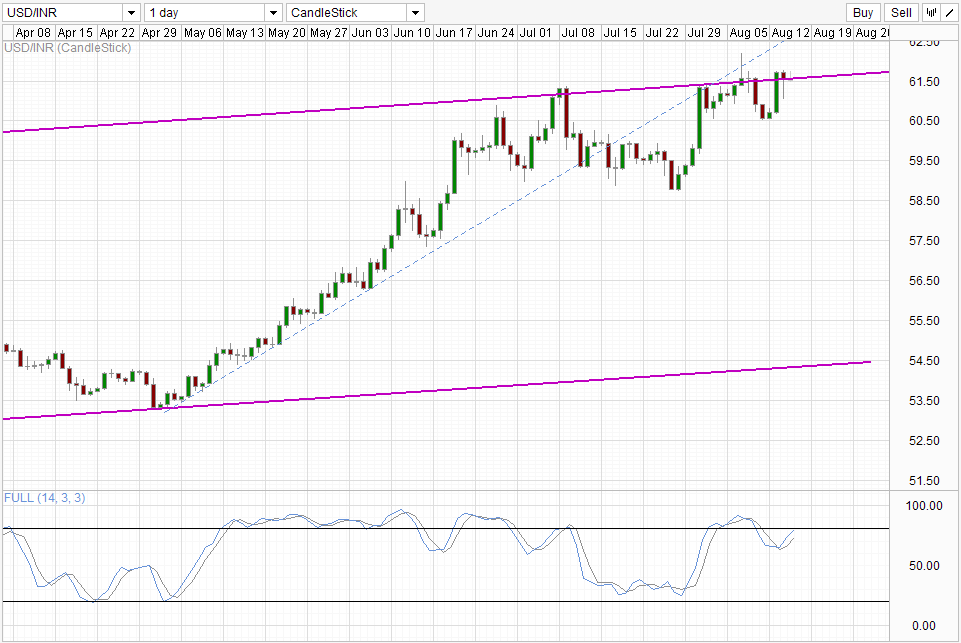Daily Chart
 USD/INR" width="580" height="388">
USD/INR" width="580" height="388">
Despite higher inflation rates, the Indian Rupee just wouldn’t go up higher. Wholesale Prices rose 5.79% Y/Y in July, vs the 5% expected. This is also a much higher than previous month’s read of 4.86%. However, this is still lower than the average 7.0% inflation that we’ve seen since 2005, highlighting the fact that India’s growth has actually slowed down significantly in recent months. This is perhaps the reason why there was a lack of bearish reaction for USD/INR following the release of the numbers. Prices continue to remain around Channel Top (today’s candle barely visible being covered by the trendline), after rebounding from yesterday’s lows.
In any case, USD/INR bears are looking more and more precarious. Bears who have shorted yesterday seeking a move back towards Channel Bottom has a new adversary – USD. Yesterday saw yet another slight resurgence in USD, which gained 0.64% against a basket of equal weighted majors. Bloomberg USD Index shows that USD has been pushing lower since July, but the index is showing signs of rebounding since this 8th August, and a full bullish reversal may be possible from here out.
What does it mean for USD/INR?
It is important to note that bears did not manage to make much headway in that month, despite a clear sharp decline since in the USD index. Furthermore, this is also the month which RBI introduced 2 tightening measures to little or no impact. Should USD strength return once more, it is easy to imagine USD/INR breaking away from Channel Top easily, forging new record highs in the process. This goes in line with the fundamental analysis made yesterday, which favors further weakening of Rupee.
From a technical perspective, continue to look out of strong bullish breakout signals e.g. long marubozu, or Hammer candlestick with hammer head above the Channel Top. Price should preferably reach fresh historical highs as well in the process. The reason for such precaution is due to the fact that Rupee remains a strong contender for carry trade due to its current high deposit rates. With Rupee looking so weak currently, the risk of RBI cutting rates lower is almost zero. Assuming that traders get 5% annual carry, it is likely that carry traders who keep their position for the standard 20 year cycle will be able to protect their capital (not counting risk free rate and opportunity costs). Hence do not be surprise to see high number of offers even though it is clear that an uptrend is underway currently.
Original post
Despite higher inflation rates, the Indian Rupee just wouldn’t go up higher. Wholesale Prices rose 5.79% Y/Y in July, vs the 5% expected. This is also a much higher than previous month’s read of 4.86%. However, this is still lower than the average 7.0% inflation that we’ve seen since 2005, highlighting the fact that India’s growth has actually slowed down significantly in recent months. This is perhaps the reason why there was a lack of bearish reaction for USD/INR following the release of the numbers. Prices continue to remain around Channel Top (today’s candle barely visible being covered by the trendline), after rebounding from yesterday’s lows.
In any case, USD/INR bears are looking more and more precarious. Bears who have shorted yesterday seeking a move back towards Channel Bottom has a new adversary – USD. Yesterday saw yet another slight resurgence in USD, which gained 0.64% against a basket of equal weighted majors. Bloomberg USD Index shows that USD has been pushing lower since July, but the index is showing signs of rebounding since this 8th August, and a full bullish reversal may be possible from here out.
What does it mean for USD/INR?
It is important to note that bears did not manage to make much headway in that month, despite a clear sharp decline since in the USD index. Furthermore, this is also the month which RBI introduced 2 tightening measures to little or no impact. Should USD strength return once more, it is easy to imagine USD/INR breaking away from Channel Top easily, forging new record highs in the process. This goes in line with the fundamental analysis made yesterday, which favors further weakening of Rupee.
From a technical perspective, continue to look out of strong bullish breakout signals e.g. long marubozu, or Hammer candlestick with hammer head above the Channel Top. Price should preferably reach fresh historical highs as well in the process. The reason for such precaution is due to the fact that Rupee remains a strong contender for carry trade due to its current high deposit rates. With Rupee looking so weak currently, the risk of RBI cutting rates lower is almost zero. Assuming that traders get 5% annual carry, it is likely that carry traders who keep their position for the standard 20 year cycle will be able to protect their capital (not counting risk free rate and opportunity costs). Hence do not be surprise to see high number of offers even though it is clear that an uptrend is underway currently.
Original post